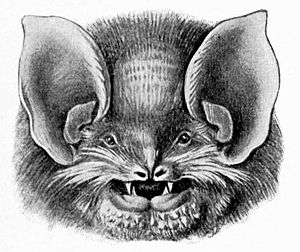Funnel tubes
| Funnel tubes | ||||||||||||
|---|---|---|---|---|---|---|---|---|---|---|---|---|

Natalus stramineus |
||||||||||||
| Systematics | ||||||||||||
|
||||||||||||
| Scientific name | ||||||||||||
| Natalidae | ||||||||||||
| JE Gray , 1866 |
The funnel ears (Natalidae) are a bat family living on the American continent . It comprises three genera with a total of five species.
distribution
Funnel tubes are native to Central and Northern and Central South America, their distribution area extends from Mexico to Brazil and also includes the Caribbean islands . On many of the smaller Antilles islands they became extinct in the course of human settlement.
description
With a head body length of 35 to 55 millimeters and a weight of four to ten grams, funnel tubes are rather smaller bats. Their long, soft fur is yellowish, reddish or brownish in color, with the underside usually being lighter. Their body is thin, the wings are slender, the legs and tail are relatively long. They get their name from the large, funnel-shaped ears, with the lower edge at the level of the mouth. There is a short, triangular tragus. The head is rounded and the forehead is strongly arched. Male animals have a special sensory organ called the natalid organ on their snout. It may be used for sensory perception or has the function of a gland, details are not known. The muzzle is elongated, but there is no nasal sheet.
Way of life
The habitat of these bats is primarily forest areas up to an altitude of 2500 meters. These animals sleep in caves, hollow tree trunks and mines, and they often socialize with other bat species. They form groups of ten to several hundred for sleeping. At night they go in search of food. Their flight is fluttering and moth-like. Their diet consists almost entirely of insects.
Reproduction
The female gives birth to a single young once a year after a long gestation period (eight to ten months). In Central America, the birth falls in the dry season. At birth, the females often form nurseries, they separate themselves from the males. Young animals are noticeably large, they reach 50% of the body weight of the mother and should also grow relatively quickly. Otherwise, little is known about the reproduction of these animals.
The species
The five types of funnel tubes were divided into three sub-genera:
- Subgenus Natalus
- Natalus stramineus is the most widespread funnel-eared species, it occurs from Mexico to Brazil .
- Natalus tumidirostris is restricted to northern South America ( Colombia to Suriname ).
- Subgenus Chilonatalus
- Natalus tumidifrons isendemicto the Bahamas . Because of its small distribution area, the species is considered endangered.
- Natalus micropus isnativeto Cuba , Jamaica and Hispaniola .
- Subgenus Nyctiellus
- Natalus lepidus lives in Cuba and the Bahamas.
In the 3rd edition of Mammal Species of the World (2005), the previous subgenera were recognized as separate genres.
supporting documents
- ↑ Don E. Wilson , DeeAnn M. Reeder (Ed.): Mammal Species of the World . A taxonomic and geographic Reference . 3. Edition. 2 volumes. Johns Hopkins University Press, Baltimore MD 2005, ISBN 0-8018-8221-4 (English, Natalidae ).